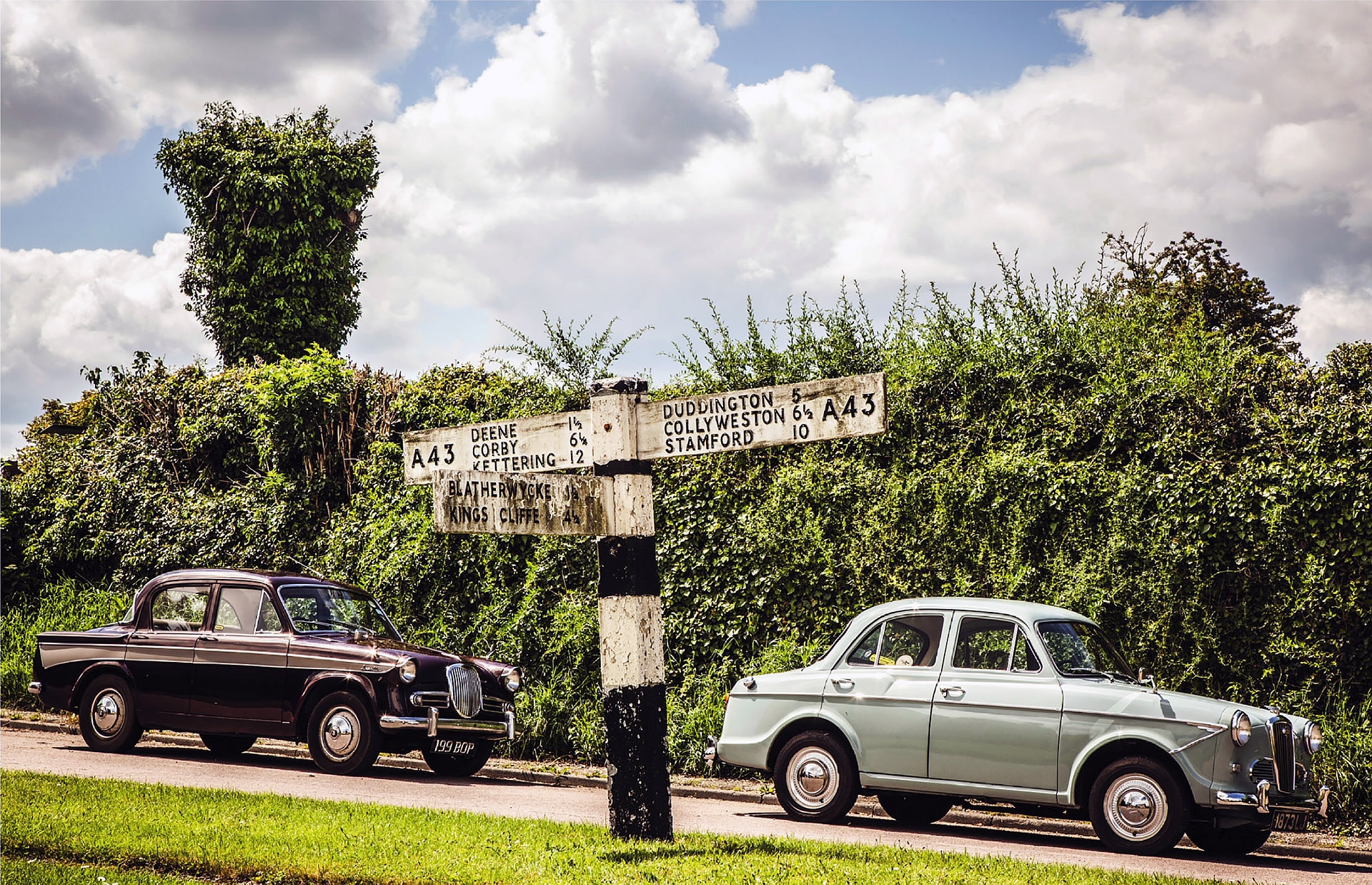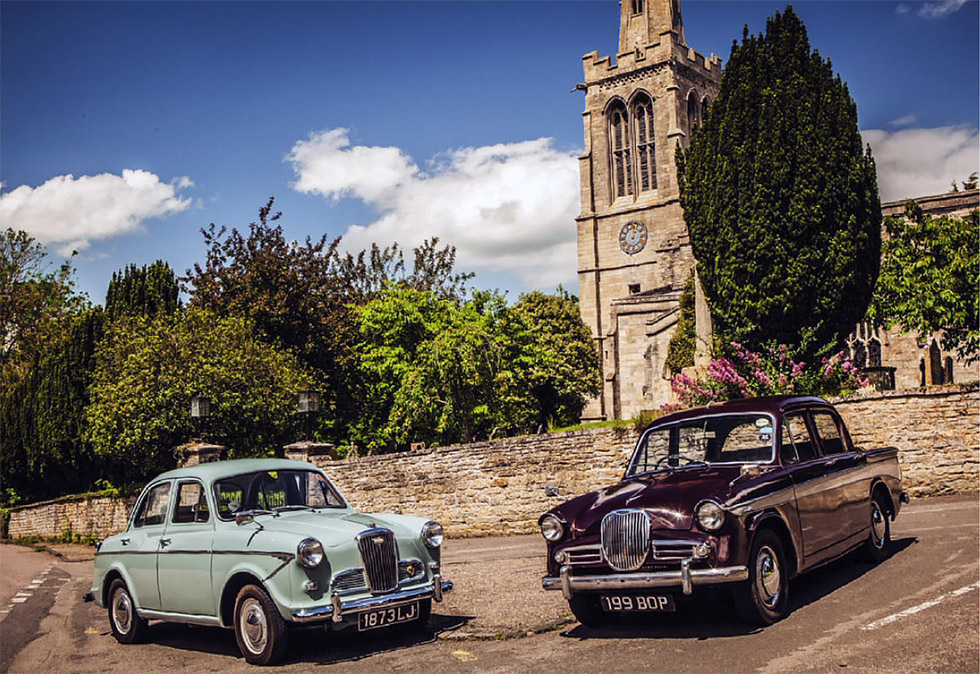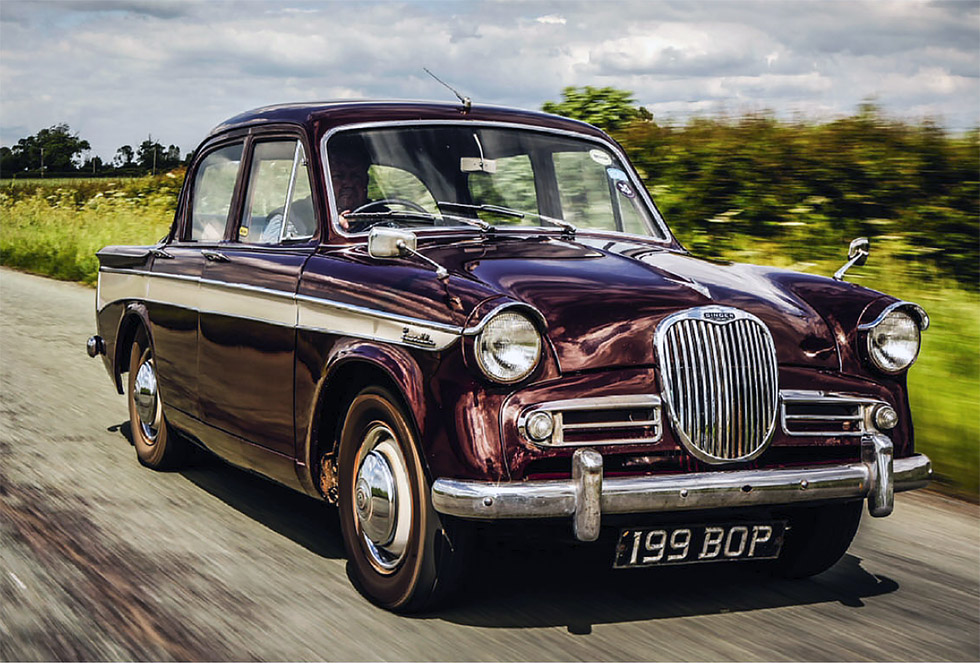
Wolseley and Singer’s bold bids to woo the British middle classes. Middleweights for Middle England. If you wanted a smart, modestly sized saloon, the Wolseley 1500 and Singer Gazelle were ideal – but which does Jon Pressnell prefer? Photography Tony Baker.
Genteel cars for gentlefolk, that was the sales pitch for the 1500 and the Gazelle. These were well-appointed mid-size saloons for those who could afford something more than a basic Minor or Minx, and wanted something with a touch of class. There was no need for anything sporting – heavens, no – but a modest aura of sub-Rover luxury would do nicely, provided the price were not too high. A compact body would suffice, as would an engine neither too big nor too small; something around that sweet spot of 1500cc would be ideal. Conveyances for older people? Quite likely, if my childhood memories of these cars in the 1960s are any guide.

This was Wolseley’s natural constituency, neatly encapsulated for the pipe-puffing classes in the marque’s motto: ‘Buy Wisely-Buy Wolseley.’ Then-parent the Nuffield Organization had missed the target with the overpriced and under-powered 4/50, but had regained customers with the elegant 4/44 and its successor the 15/50. But what the sales network was crying out for was a modern ‘Wolseley Ten’ – something a bit smaller than the Palmer-designed saloons but with the same-sized 1250-1500cc engine.
The answer came in a roundabout way. Minor owners had long complained about the lack of a decent engine for the small Morris. After the Austin-Morris merger, BMC accordingly developed a rebodied Minor that was intended to have a 1200cc version of the corporate B-series unit. But the Minor’s market share carried on holding up nicely; further to this, 1956 would bring a vastly improved 948cc engine that at last gave the Morris acceptable performance and further boosted sales. So was there any need to replace the evidently still competitive Issigonis design?

BMC had a rethink. Wolseley dealers wanted their ‘New Ten’ and Riley agents wanted some-thing – anything – that was more saleable than the Pathfinder that was all they could offer. A neat solution would be to tart-up the would-be Minor replacement with some wood and leather, pop in the 1489cc B-series, in two different tunes, and – hey presto! – sell the car as a Wolseley and a Riley to solve both problems.
‘The 1500 looks tall and conservative next to the singer’s bright modernity’
So was born the Wolseley 1500, launched in April 1957 with a single-carb 43bhp engine and followed in November by the twin-carb 62bhp Riley One-point-Five. Right to the last, there was thought of a pared-down Morris version, still with the 1200cc power unit; this eventually saw service in Australia, only with the 1489cc engine, as the Morris Major and Austin Lancer.
The Rootes Group arrived at the same place by a more direct route. It had the sporting side of the market covered by the Sunbeam marque – or Sunbeam-Talbot, as it was until 1954. But there was no Rootes equivalent to Wolseley. The purchase of Singer in 1955 changed all that.
There was no point in keeping Singer’s dead-in- the-water Hunter and Roadster in production, and Rootes had no money to develop a standalone Singer, even had it wanted to do so.
But adding plusher trim to the upcoming Audax Minx would provide the mid-market brand the combine was lacking, and keep the Singer name alive. So it was that in September 1956 Rootes announced the Gazelle – complete, for a while, with the single-overhead-cam Singer engine. With the arrival of the Series IIA Gazelle in August 1958, this venerable unit was replaced by the pushrod 1494cc motor from the Minx, in single-Solexform developing 56bhp.

Low-mileage Wolseley responds tautly. Right: nicely appointed dash, with two gloveboxes; less powerful than Singer but it’s 122kg lighter; decent boot, with separate spare.
At £796 in 1958, the Wolseley was £102 cheaper than the Gazelle IIA, but the two were still close competitors – because of their similar specs but also because, enviably, no other models occupied this niche. Both were resolutely conventional rear-drive designs, with semi-elliptics at the rear and drums all-round. Being based on the Minor floorpan, the 1500 inherited the torsion-bar front suspension and rack steering of the Morris, along with its lever-arm dampers at front and rear. The Gazelle, meanwhile, had a coil-and- wishbone front, complete with anti-roll bar, and boasted telescopic dampers at all four corners. It made do, however, with steering by box, this being recirculating ball from the IIA onwards.
The two cars did well for their makers. By the time that the Wolseley was withdrawn in 1965, an impressive 103,394 had been made, against just 39,568 One-point-Fives. That made it the best-selling car in Wolseley’s history. Rootes wasn’t far behind, building 83,061 Series I-VI Gazelles, the last in 1966. As with the Wolseley, the Singer outsold its supposedly more desirable sporting sister, albeit by a smaller margin, a total of 66,809 Audax Rapiers being constructed.
Put the two together, and you see two very different styles of vehicle. Gerald Walker’s 1961 Wolseley looks tall, narrow and conservatively old-maidish – although both cars are the same height and width, give or take a fraction of an inch. Launched just a year before the revolutionary square-cut Farina A40, the BMC car’s staid lines show how off-the-boil had become the company’s design studios at Longbridge. No wonder 1500 sales would taper away during the ’60s. Andrew McAdam’s 1960 SIIIA Gazelle, meanwhile, has a bright Americanised modernity about it, aided by the subtle roll-over rear fins introduced in late 1959 with this generation of Audax Minxes and Gazelles. As we’ve said, the Singer is not leaner and lower, but it is longer than the Wolseley, by exactly a foot.

From top: front bench with armrest, separate buckets were optional; lively, all iron engine; it looks like a shrunken Yank from rear, nice quick-release filler.
The interiors send out the same message: that of the Wolseley being quaintly old-fashioned, that of the Singer more airy and crisply contemporary. You can quibble about the mismatch of the veneers, but the 1500’s dash is a nicely integrated piece of work, and incorporates dials with classically elegant faces, while the chrome- rimmed switches and dished wire-spoke wheel are equally charming. In contrast, the Gazelle’s timberwork might be neatly mirrored, but it is so manifestly add-on and has that characteristically Rootes over-glossed finish. The dials have brasher lettering and there is a gruesomely fake woodgrain finish to the heater/radio console.
In brief, there’s a more naturally classy feel to the Wolseley, even though Walker’s car, a lower-cost Fleet model, lacks the leather trim of regular 1500s. Both cars are just about adequate four-seaters, and feel to have about the same amount of rear legroom – although figures show the vynide-trimmed Singer to be more generous here, as well as offering more internal width. The boots of the two cars are a good size, which is a rewarding practical bonus.
Slip into the slightly low-set bucket seat of the Wolseley, and you discover a usable get-in-and-go machine, demanding no acclimitisation even for someone who might have just a nodding acquaintance with old cars. Aided by a smooth hydraulic clutch, the notchy, short-throw gear- lever slots in sweetly every time, with a pleasant metallic click as you go through the gate. The steering is delicious. Quick, free of play and perfectly weighted, it allows you to hold the car effortlessly on its line and corner at a decent lick.
You couldn’t call the engine refined; it’s a tad coarse, even, until you throttle back. But it pulls well, despite a relatively high final drive, and can cope with top from a little over 20mph. What this means is that progress cross-country is brisk and unflustered, with no need for continual gearchanging. It’s happy doing 50mph and at an indicated 60mph the Wolseley is still unstressed, with power in reserve: the car is working much less hard than even a 1098cc Minor, latterly part of its mission. An output of 43bhp might not be a lot, but maximum torque, at 74lb ft, is up by roughly 50% on that of a 948cc Minor, even if it comes in 500rpm later, at 3000rpm. It also pays to bear in mind that the Wolseley might be frumpy, but with a kerb weight of 2061lb (935kg) it’s not all that lardy: it tips the scales a full 270lb (122kg) lighter than the Singer.
The 1500 corners flatly and, despite the extra weight of the B-series engine relative to the Minor’s A-series, there is no noticeable nose-heaviness even when driving vigorously. There’s a bit of jounce on undulating surfaces, but the Wolseley generally rides well. Uncorrupted by a servo, the brakes are firm, take up immediately, and give instant check braking along with effective stopping from speed. Indeed, the 1500 is a car of relatively firm inputs all-round – giving a pleasant harmony to the controls.
‘Neither the Singer nor the Wolseley changed much during their lives’
Moving to the Gazelle, the first point to make is that if you had bought a Series IIIA, current only for the 1960 model year, you had struck lucky. By a strange aberration of product planning, the IIIA alone had a 60bhp twin-carb engine and a Rapier close-ratio ’box. That made it almost as quick as the Sunbeam, which didn’t make much sense and, after just one season, the IIIA was replaced by the IIIB with a 56bhp single-carb unit. Whatever the engine, the pushrod Gazelles were also available with an optional overdrive, operating on third and top – as on McAdam’s car. It’s a package that can only give the Singer a performance advantage over the born-to-be-mild Wolseley, and so it proves.
The Gazelle’s engine is smoother, revvier, and really is sprightly, with crisp responses that enable the Singer to hit 70mph with ease, in overdrive top and still accelerating strongly. Impressively, the overdrive does not rob the car of performance, despite dropping engine speed noticeably. Over the same roads, you find your-self doing 5-10mph more than in the Wolseley. McAdam sings the praises of the IIIA, which he regards as flexible without being too low geared, and perfectly set-up for long-distance cruising.
He also says that the 1494cc engine is sweeter than the subsequent 1592cc and 1725cc units.
Nor is it any hardship to exploit this performance. The clutch is smooth and there’s a sportily short-throw gearlever – although a column change could be specified. The unservoed brakes come in more softly – lacking the immediacy of those on the Wolseley – but are up to the job.
Yet if the Singer makes a convincing case with its drivetrain, it doesn’t have it all its own way. The steering is slower and less communicative than that of the Wolseley, while, despite a front anti-roll bar, the Gazelle leans more and rides in a softer and slightly under-damped fashion. The Singer holds the road well enough, although it feels bigger and less poised than the Wolseley – albeit more modern, faster and ultimately more sporting, at least as far as performance goes.
Which to choose? In some ways the Singer is identifiably superior – and from youthful experience, I know how these cars can be dramatically improved by fitting Koni dampers or similar. As it stands, though, the Wolseley may lack the Singer’s verve but it has its own sporting side, thanks to its crisp steering and general tautness of feel. It also has a certain old-fashionedness that I find appealing, and forme that tips the balance in the BMC car’s favour. Others, of course, might be tempted by the Singer’s more contemporary character, and vote differently.
Thanks to the Wolseley Register (wolseleyregister.co.uk); the Wolseley OC (wolseleyownersclub.com): the Association of Singer Cor Owners (osco.org.uk) and the Singer OC (singeroc.free-online.co.uk)
Evolution not revolution
Both the Singer and the Wolseley changed little during their lifetimes. The 1500 in particular underwent barely more than a few minor cosmetic tweaks.
In May 1960, the bonnet and boot gained concealed hinges; in October 1961, the model was given lowered suspension, new side grilles with round indicator/sidelight units, and Austin A40 Farina tail-lights; for 1963, there was a stiffer crankshaft and a stronger gearbox, albeit still with an unsynchronised first gear.
As for the Singer, after the overhead-cam Series I and Series II Gazelles and the physically identical pushrod Series III, the Series IIIA received roll-over fins and a larger front windscreen, as well as having the twin- carb engine. After the single-carb but otherwise unchanged IIIB of August 1960 to July 1961, the IIIC of the 1962 and 1963 seasons had a 53bhp 1592cc engine.
This was carried over to the Series V, introduced in September 1963, which had a revised square-roof glasshouse, plus front discs and 13in wheels, along with a new dash. An all-synchro ‘box came in for 1965 and, for the Audax Gazelle’s last year, the Series VI had a 1725cc engine and a new lowline grille.
Convertible Gazelles were available until February 1962, and estates in Series II through to Series IIIC formats.





